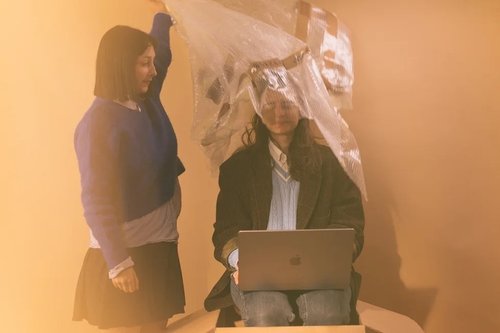From tech to television: the benefits of alumni networking
Jul 30, 2024
6 mins


Journalist
Even if you loved your time in college, it’s natural to feel that those days are behind you once you leave. You’ve got your degree—and a chunk of debt—so there’s no need to hang around any longer. As you embark on the next stage of your life, you will meet up with the friends you made in class, so why would you want to stay in touch with your university, particularly through such a formal relationship as an alumni group? For some graduates, their alumni networks were a key part of their career path. So, how can you make them work for you?
Opening doors
Breaking into television isn’t easy and achieving success there is even tougher. So, Kristen V Carter knew she had to work hard if she was to achieve her dreams. Gaining her BA in television production from Hofstra University in 2006 was just the start. Carter recognized early on that making the right connections would be key to her journey. So she joined the college alumni association and has made full use of it.
“I make it a point to push myself to hit send on my alumni check-ins and to participate in alumni reunions,” she says. “I also find a way to go beyond the alumni association so that I can add value to the organizations or offices that are a bit more intimate. For example, I am involved in Hofstra’s School of Communications more actively than the general Alumni Relations. That decision is purposeful so that I can build and maintain stronger relationships, and make a greater impact.”
Carter learned the value of having the right professional connections when she was still studying at Groton School, a private institution in Massachusetts. Her guidance counselor suggested that she reach out to Stephen G Hill, a television executive who had graduated from Groton School in 1980. “As a result of connecting with him, I landed my first internship during the summer before my college freshman year where I served as an intern for cable channel BET’s 106, Park Music Video Show and Rap City,” she says. “During that time, I was able to meet and forge a relationship with my internship supervisor who became one of my mentors who supported my growth within the television industry.”
These days, Carter is an award-winning television writer, producer and filmmaker. In 2022, she was an executive producer for the Discovery+/OWN four-part documentary series Profiled: The Black Man, which looks at debunking stereotypes that Black men in America have faced for centuries. Earlier this year, she was showrunner and executive producer for the music celebration entitled GOSPEL Live! presented by respected literary critic and professor Henry Louis Gates Jr, which aired on PBS.
“Since graduating, I have spoken to the Television Production majors year after year and have served as a speaker for the Hofstra in LA program, which sponsors a select number of students to come to LA for one to two weeks and learn about life in and around Hollywood,” she says.
The power of connections
Thanks to the strong relationship she has with her alma mater, Carter is the newly appointed semester coordinator for the expansion of Hofstra in LA, which begins in January 2025. “Hofstra has been extremely supportive of my ascension from a student to executive producer,” she says, adding that her high school and college communities have been essential to the growth of her career.
There are almost 4,000 third-level institutions in the United States many with highly developed alumni networks. Some are free. Others, such as Penn State University, which boasts 775,000 members, charge a fee. The Harvard Alumni Association has more than 400,000 members around the world. The University of California boasts 2 million alumni. So, there are plenty of opportunities to make connections, though experts say the smaller institutions often offer more value to their alumni than larger ones.
Small schools, big results
That’s been the experience of Tad Druart, who graduated from Newman University in 1987. Druart took his time getting involved with his alumni network as he was busy making use of business networks. It all started to come together for Druart after he joined the Newman alumni board, serving as its president in 2013 when the alumni network had 11,000 members. “As part of that role, I began reaching out to meet people and see how we could help them. Over the years, those relationships grew from acquaintances to some great friends,” he says.
Druart, who is vice president of client services at Pierpont Communications, also found work. “I had job and consulting opportunities offered me through that network,” he says. Druart’s son, who is studying law at the University of Michigan, has also benefited. “As a strong liberal arts institution, Newman has a large number of former students in the legal profession,” he says. “Those connections were willing to introduce him to people or meet with him to help him pick Michigan. It’s opened doors to learning opportunities with the Justice Department in Washington DC, Texas Office of the Attorney General, and law firms both large and small.”
Standing out from the crowd
Dr. Kyle Elliott, the tech career coach behind Caffeinated Kyle, is such a fan of alumni networks he belongs to three: San Francisco State University, the University of Washington, and the University of North Dakota. “Alumni networks have helped me professionally when looking for new opportunities,” he says. “Reaching out to fellow alumni at companies allowed me to stand out from fellow applicants and secure multiple interviews that I’m not sure I would have otherwise.”
One advantage of alumni networks is that you likely share many experiences with those you’re reaching out to, he says. “Living in the same city, having eaten at the same restaurants, and sharing similar memories can make breaking the ice easier, particularly in our digital-first world,” says Elliott. “You may know some, or many, of the same people, which further supports trust building. People are often more willing to support you with your job search and career if they like and trust you.”
This matters particularly when it comes to seeking a role at a prestigious company. “People who work at sought-after companies like Netflix, Google, and Microsoft are often bombarded with outreach messages from people wanting to network,” says Elliott, who has helped executives to land roles at many of America’s tech giants. “Having a shared connection point, such as having gone to the same university, can make the process of reaching out less intimidating and increase the likelihood of receiving a response to your message.”
Many of Elliott’s clients are part of alumni networks too. “One of the greatest values they find is when they’re looking for a new job and want to gather insights from someone ‘on the inside’ who can shed light on an organization’s culture beyond just the company’s careers page or Glassdoor reviews, which offer a limited perspective,” he says.
Like Druart and Carter, Elliott is quick to highlight that you will get out of any network only what you put into it. “There’s little risk and so much reward when you strategically and intentionally build your community,” says Elliott. “You must be willing to put yourself out there.”
10 tips to make the most of your alumni network
1. You must take action. This means doing your research, making contact, and then following up in person or online.
2. Have a system to keep your connections organized. “It’s easy to get overwhelmed with the process of networking,” says Elliott. “Have a simple spreadsheet where you track who you connected with, what you discussed, and your action items from the call.”
3. Ask for more. “At the end of any call, ask who else in the industry they recommend you speak with, and then ask them to make a personal introduction to the person, as this will help keep your momentum going.”
4. Don’t expect too much too soon. “Alumni networks are what you make of them,” says Elliott. “You can’t expect to join a network and receive a job offer overnight. You must put in the work and proactively reach out to fellow alumni.”
5. Get familiar with LinkedIn. Many alumni networks run classes on how to master this platform. “LinkedIn is a powerful tool for finding people at your target companies. You can use the platform’s robust search features to specifically seek out alumni who are current or previous employees at your dream company.”
6. Do your homework before attending events. If you can, get a list of attendees and read up on their organizations and their backgrounds. Come up with some questions. “This helps you learn, but it also deepens your connection with them and reveals you as curious and thoughtful to grow.”
7. Keep your spirits up. “Try not to feel defeated if you reach out to someone and they don’t respond,” says Elliott. “While easier said than done, don’t take it personally, as they likely just missed your email or didn’t check their LinkedIn inbox. They’re probably not intentionally ignoring you.”
8. Do it your way. “Thankfully, you don’t have to be a social butterfly to benefit from joining your alumni network,” says Elliott. “If you’re a fellow introvert, you can use your alumni directory to connect one-on-one with fellow alumni in your industry and at target industries.”
9. Don’t worry if you’ve moved away. “If you no longer live where you went to school, that’s okay too,” says Elliott. “One of the silver linings of the pandemic is that many universities have introduced more virtual events and networking opportunities.”
10. Ask for help. “If you’re feeling stuck, don’t hesitate to reach out to the staff at your university’s career center or alumni association for support,” says Elliott. “That’s their job, after all. If there’s a specific company you want to work at, for instance, you can inquire whether the staff knows any alumni who currently or previously worked there.” Your college wants you to succeed, not just so that it can make a generous donation, but so that you can spread the word about what a great institution it is.
Photo: Welcome to the Jungle
Follow Welcome to the Jungle on Facebook, LinkedIn, and Instagram and subscribe to our newsletter to get our latest articles every week!

More inspiration: Network for the job hunt

Messaging recruiters: 7 mistakes to avoid on LinkedIn
Think messaging a recruiter on LinkedIn guarantees an interview? Not if you make these mistakes. Here's how to get noticed for the right reasons.
Dec 02, 2024

How to network in tech with no experience
Networking can be daunting for anyone, but entry-level tech workers have a unique challenge ahead.
May 30, 2024

Make your mark: How to build a personal brand for the job hunt
What’s the secret to success in today’s job market? None other than personal branding.
Apr 22, 2024

Telling your story: How to craft a LinkedIn bio that will stand out to recruiters
This social media tool is at the tip of your fingers, and we bet you don’t know what you’re missing …
Feb 13, 2024

Messaging recruiters on LinkedIn: Should you go for it?
Your ultimate guide to strategically sliding into a recruiter’s DMs … without being annoying.
Jan 31, 2024
The newsletter that does the job
Want to keep up with the latest articles? Twice a week you can receive stories, jobs, and tips in your inbox.

Looking for your next job?
Over 200,000 people have found a job with Welcome to the Jungle.
Explore jobs